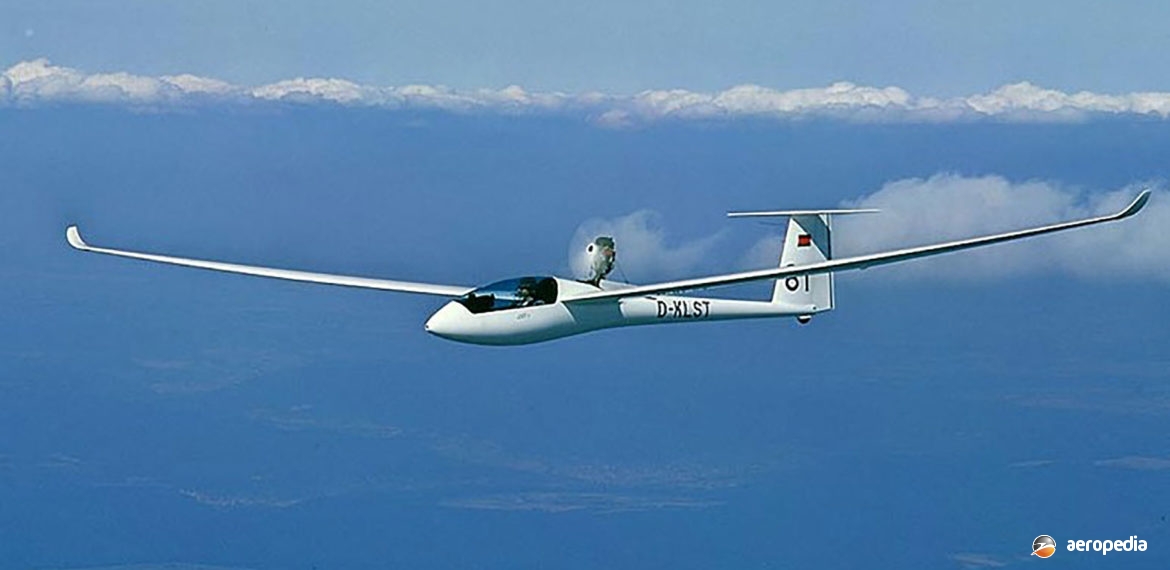Photograph:
German registered DG Flugzeugbau LS-8-T D-XLST in Germany (DG Flugzeugbau)
Country of origin:
Germany
Description:
Single-seat self-launched sailplane
Power Plant:
One 19.6 kw (26 hp) Solo 2350 two-cylinder two-stroke air-cooled engine
Specifications:
- Wingspan: 15 m (49 ft 3 in)
- Length: 6.72 m (22 ft 1 in)
- Height: 1.33 m (4 ft 4 in)
- Wing area: 10.5 m² (113 sq ft)
- Max speed: 280 km/h (175 mph)
- Max glide ratio: ca.43
- Aspect ratio: 21.4
- Rate of sink: 35 m/min (116 ft/min)
- Max wing loading: 50 kg/m²
- Empty weight: 250 kg (550 lb)
- Loaded weight: 525 kg (1,155 lb)
History:
The DG Flugzeugbau LS-8 series of high-performance gliders emanated from Germany and was designed in 1994 to meet the requirements of some operators to have an engine for sustaining flight to prevent out-landings and sometimes damage to the aircraft. Production commenced in 1995 and the series originally was for high-performance gliding but it was decided to install an engine to permit the pilot to get home on a weak-wind day, and also permit the pilot to travel across weather borders. It has been said the LS-8-s (‘s’ for self-sustainer) with the increased wingspan carried the additional weight of the engine installation better than a pure 15 m glider.
The fuselage of the aircraft remained the same, not having to be enlarged or changed to any real extent to fit the engine. The engine fitted was the Solo 2350 two-cylinder two-stroke unit which has been installed in a number of gliders over the years. It was fitted with a two-blade propeller produced by Technoflug and the additional weight of the engine of 40 kg (88 lb) and the fuel load of 10 kg (22 lb) resulted in a climb performance of 60 m to 90 m (197 ft to 295 ft) per minute and a range of 300 km (186 miles) or an endurance of one hour. If required the engine and propeller combination could be removed or re-installed at any time. A customer, if he or she so desired, could purchase an LS-8 without the engine installed but ready for installation.
The series was initially known as the Rolladen-Schneider LS-8 but that company had some problems and in later years the glider was constructed by DG Flugzeugbau with which some alterations were made and new variants produced. The initial production machine had some improvements from the prototype which involved a re-design of the ailerons and a lighter and aerodynamically cleaner wing, this involving the removal of the flap system. The aircraft was available with either a 15 m (49 ft 3 in) or 18 m (59 ft) wing.
The type was seen in this part of the world when LS-8s achieved 2nd, 4th and 5th positions in the 1995 World Gliding Championships at Omarama in New Zealand; and 1st, 2nd and 3rd in the 1997 World Gliding Championships at St Auban in France. It also achieved six of the first ten positions in 1999; three places in the 2001 Womens World Gliding Championships in Lithuania and high places in championships around the world since then. More than 500 examples have been completed.
At least one example of the LS- 8-T has been imported to Australia, this machine owned by Praveen Vats of Mount Waverley, VIC, being imported in mid 2016 and becoming VH-EST (c/n L8530).

